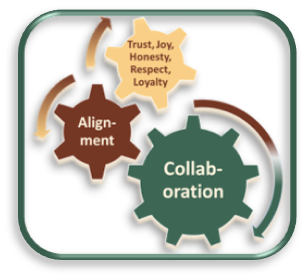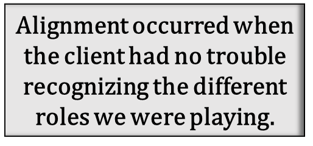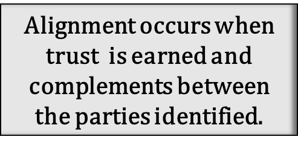The Key to Collaboration is….

My entrepreneurial journey over the past 17 years, and especially over the last 4, has depended upon collaboration. That collaboration has manifested itself in many ways; a great partner, referrals from thoughtful clients, learning in a peer to peer professional group, interdisciplinary alliances, a colleague who recognized a unique skill set and associates who understand when 1+1 > 2.
While examining why some collaboration is wonderfully successful while other collaboration fails, I came to one big realization. The key to successful collaboration is alignment (definition: arrangement in appropriate relative positions). While there are other important factors, I will list them later, it is alignment that has been the key success factor in my collaborations.
Alignment does not mean we have the same goals in mind or even that we think the same way.
Alignment means, when I act on your behalf, you are improved and when you act on my behalf, I am improved. In the case of business, when we act together, the customer or client is also improved.

Let me give a few examples. A friend and brilliant business person I have known for quite a few years tried to bring me into a number of his projects since the first time we met. Our skill sets were similar and the economics of having us on the same team became a difficult hurdle for his clients to overcome. We had the illusion there was alignment because we enjoyed one another, were highly skilled and assumed the client would recognize this. But we were not aligned to the economic realities of the client, who saw us as similarly skilled and high priced.
When my friend took on a role in an industry I was very familiar with and he was not, he asked me to join him. Our roles could easily be delineated for the client and the value I created as CFO could clearly be separated from his strategic business leader role. Alignment occurred when the client had no trouble recognizing the different roles we were playing.

Earlier, I noted alignment is not dependent on having the same thought process. In fact, I will go a step further. Thinking the same way can actually disrupt alignment. Alignment is all about creating greater value. If we think in the same way, the most we can get from collaboration is 1+1=2. Given that collaboration requires taking time to communicate with one another, when we think alike, 1+1 is actually something less than 2. Not only does it take extra time, but something will get lost in the translation. Thinking alike does not give the client more value. This concept is not only a key to successful collaboration. It is also why diversity on our teams can create so much value.
Here is another example. I have known one of my ‘competitors’ for over 3 years. I really enjoy him and respect his work but we perceived each other as battling for the same customers. This gave us a 1 + 1 = 2 perspective about growing our potential collaboration. We enjoy each other, so we stay in touch and invariably discuss our businesses. At first, both of us were somewhat guarded to prevent from revealing our ‘secret sauce’ to one another. The more we learned about each other, the more we learned from each other.
Alignment occurred when we both recognized our different ways of thinking added a new perspective to each of our practices. Since that realization we have begun working on some joint efforts and are in the middle of a significant collaboration we are both looking forward to.

Here is an example of how the right partner can make a great collaborator. In my last ‘corporate’ CFO job I had a boss I really enjoyed working with. We made an excellent team and found the challenges of work full of exciting opportunities. We left the company within a year of each other but kept in close contact.
When he took a new job, he asked me to help him out with one of his operations. That ‘gig’ started my entrepreneurial journey. Later that summer I began a CFO advisory service that survives today. Three years later when he returned to the United States, we formed a partnership. That business served agricultural companies and their investors for nearly 15 years.
A partner who complements the skills you bring to the table, creates the type of alignment that can be parlayed into a profitable collaboration.

At CFO.University we have dozens of collaborators, we call them ‘Contributors’, who share their CFO-centric thought leadership with our community. I hand selected them because their lessons are some of the best I can find for CFOs and finance leaders. They agree to share their teaching with us because we offer a well-recognized, highly credible global platform to distribute their work. Our community is made up of the highest quality finance leaders in the world. They see value in being part of that. Alignment occurs when our Contributors gain by teaching on our platform and CFO.University gains by making their expertise available to our community.
The last example I will share highlights how trust and complements create alignment and the potential for collaboration. I was introduced by a good friend to the executives of a group based in Dubai. They develop software to improve finance processes. A key customer of theirs is the CFO and other finance leaders. In our initial meetings we decided to undertake a significant project, to organize a virtual global summit for finance leaders. We met and within a week agreed to co-host a 2 day global summit within 2 months. The 1500 attendees were inspired by the 18 global business leaders who delivered lessons at the Summit. That timeline is a testament to trust and complements.
First, the team at the software company quickly earned my trust. They committed significant resources, always valued our input and treated our informal partnership with great respect. Importantly, they always did what they said. Those actions and behaviors earned my trust in very short order.
Second, we served the same customer base but with complementary products. (For an example on how this works for M&A read When Searching for Merger Candidates - Substitutes and Complements Make All the Difference) This allowed us to focus on the profile of delegates – primarily CFOs and finance leaders - we wanted to attract to the summit, while our different experience gave us a robust list of topics to share at the summit. Alignment occurred quickly in this relationship when trust was earned and our complements identified.

You may recognize the summit as the Finance Innovation and Excellence Summit (FInEx Summit) and our partner as AARO Middle East. AARO and CFO.University have now hosted the FInEx Summit for 4 straight years.
In addition to the alignment examples noted above, I use the following checklist to guide our collaborative efforts.
_____ We enjoy working with our collaborators
_____ We can be honest and forthright with our collaborators
_____ We respect our collaborators and the way they conduct business
_____ The collaboration is mutually beneficial with high potential benefits to both parties
_____ We can have a healthy debate with our collaborators
_____ There is little friction within our collaboration
_____ We are confident we won’t breach the trust of our collaborators (Loyal)
_____ We are willing to advocate for our collaborators
Please, let me know what you would add to this list.
Identify your path to CFO success by taking our CFO Readiness Assessmentᵀᴹ.
Become a Member today and get 30% off on-demand courses and tools!
For the most up to date and relevant accounting, finance, treasury and leadership headlines all in one place subscribe to The Balanced Digest.
Follow us on Linkedin!
